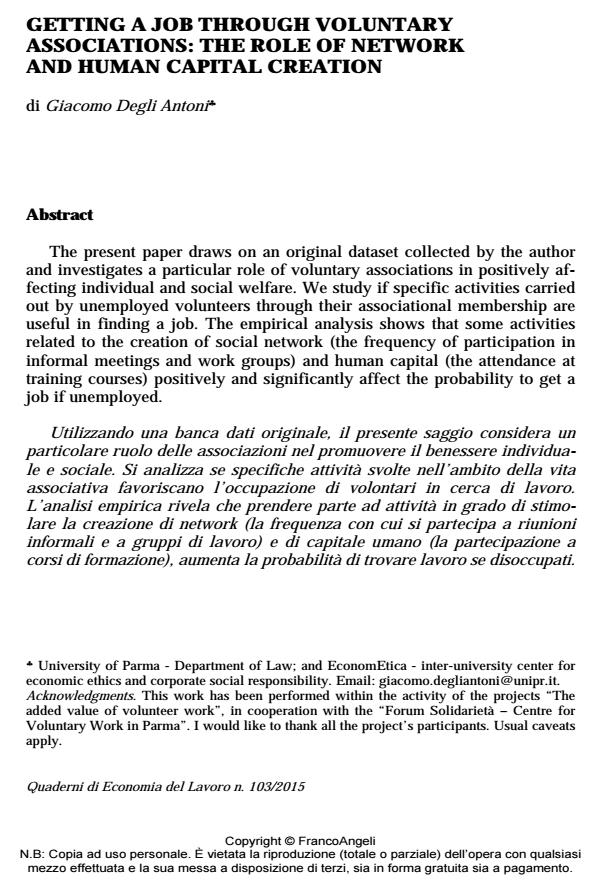Getting a job through voluntary associations: the role of network and human capital creation
Titolo Rivista QUADERNI DI ECONOMIA DEL LAVORO
Autori/Curatori Giacomo Degli Antoni
Anno di pubblicazione 2015 Fascicolo 2015/103 Lingua Italiano
Numero pagine 18 P. 49-66 Dimensione file 111 KB
DOI 10.3280/QUA2015-103004
Il DOI è il codice a barre della proprietà intellettuale: per saperne di più
clicca qui
Qui sotto puoi vedere in anteprima la prima pagina di questo articolo.
Se questo articolo ti interessa, lo puoi acquistare (e scaricare in formato pdf) seguendo le facili indicazioni per acquistare il download credit. Acquista Download Credits per scaricare questo Articolo in formato PDF

FrancoAngeli è membro della Publishers International Linking Association, Inc (PILA)associazione indipendente e non profit per facilitare (attraverso i servizi tecnologici implementati da CrossRef.org) l’accesso degli studiosi ai contenuti digitali nelle pubblicazioni professionali e scientifiche
The present paper draws on an original dataset collected by the author and investigates a particular role of voluntary associations in positively affecting individual and social welfare. We study if specific activities carried out by unemployed volunteers through their associational membership are useful in finding a job. The empirical analysis shows that some activities related to the creation of social network (the frequency of participation in informal meetings and work groups) and human capital (the attendance at training courses) positively and significantly affect the probability to get a job if unemployed.;
- Brehm J. and Rahn W. (1997). Individual-Level Evidence for the Causes and Consequences of Social Capital. American Journal of Political Science, 41(3): 999-1023.
- Calvó-Armengol A. and Jackson M.O. (2004). The Effects of Social Networks on Employment and Inequality. The American Economic Review, 94(3): 426-454.
- Claibourn M.P. and Martin P.S. (2000). Trusting and Joining? An Empirical Test of the Reciprocal Nature of Social Capital. Political Behavior, 22(4): 267-291.
- Degli Antoni G. (2009). Intrinsic vs. Extrinsic Motivations to Volunteer and Social Capital Formation. Kyklos, 62(3): 359-370.
- Evans R.W. and Koch T.G. (2007). Human Capital, Unemployment Duration and Individual Heterogeneity. --http://econ.byu.edu/Faculty/Evans/Papers/UIben.pdf.
- Franzen A. and Hangartner D. (2006). Social Networks and Labour Market Outcomes: The Non-Monetary Benefits of Social Capital. European Sociological Review, 22(4): 353-368.
- Granovetter M.S. (1974). Getting a Job: A Study of Contacts and Careers. University of Chicago Press.
- Haski-Leventhal D. (2009). Elderly Volunteering and Well-Being: A Cross-European Comparison Based on SHARE Data. Voluntas: International Journal of Voluntary and Nonprofit Organizations, 20 (4): 395–421.
- Ioannides Y.M. and Datcher Loury L. (2004). Job information networks, neighborhood effects and inequality. Journal of Economic Literature, 42: 1056–1093.
- Kiefer N. (1985). Evidence on the Role of Education in Labor Turnover. Journal of Human Resources, 20(3): 445–452.
- Mayer N. (2003). Democracy in France: Do Associations Matter? In: Marc Hooghe and Dietlind Stolle, eds., Generating Social Capital Civil Society and Institutions in Comparative Perspective. Palgrave Macmillan.
- Menchik P. L. and Weisbrod B.A. (1987). Volunteer labor supply. Journal of Public Economics, 32: 159–83.
- Meyer B.D. (1990). Unemployment Insurance and Unemployment Spells. Econometrica, 58(4): 757–782.
- Meier S. and Stutzer A. (2008). Is Volunteering Rewarding in Itself? Economica, 75: 39-59.
- Montgomery J.D. (1991). Social Networks and Labor-Market Outcomes; Toward an Economic Analysis. The American Economic Review, 81(5): 1408-1418.
- Prouteau L. and Wolff F.C. (2004). Relational Goods and Associational Participation. Annals of Public & Cooperative Economics, 75(3): 431-463.
- Putnam R., Leonardi R. and Nanetti R. (1993). Making democracy work. Princeton: Princeton University Press.
- Rogerson R., Shimer R. and Wright R. (2005). Search-Theoretic Models of the Labor Market: A Survey. Journal of Economic Literature, 63(4): 959–988.
- Salamon L.M. and Sokolowsky W. (2004). Global Civil Society: Dimensions of the Nonprofit Sector. Volume II. Bloomfield, CT: Kumarian Press.
- Schiff J. (1990). Charitable Giving and Government Policy. An Economic Analysis. New-York: Greenwood Press.
- Sherraden M. S., Lough B. and McBride A. M. (2008) Effects of international volunteering and service: Individual and institutional predictors. Voluntas: International Journal of Voluntary and Nonprofit Organizations 19 (4): 395-421.
- Stolle D. and Rochon T.R. (1998). Are all Associations Alike?: Member Diversity, Associational Type and Creation of Social Capital. American Behavioral Scientist, 42: 47-65.
- Tocqueville A. (1840). De la démocratie en Amérique. (English translation: Democracy in America. Chicago: Chicago University Press, 2000).
- Wollebæk D. and Selle P. (2002). Does Participation in Voluntary Associations Contribute to Social Capital? The Impact of Intensity, Scope, and Type. Nonprofit and Voluntary Sector Quarterly, 31(1): 32-61.
- Wollebæk D. and Selle, P. (2003). The Importance of Passive Membership for Social Capital Formation. In: M. Hooghe and D. Stolle, eds., Generating Social Capital Civil Society and Institutions in Comparative Perspective. Palgrave Macmillan.
Giacomo Degli Antoni, Getting a job through voluntary associations: the role of network and human capital creation in "QUADERNI DI ECONOMIA DEL LAVORO" 103/2015, pp 49-66, DOI: 10.3280/QUA2015-103004